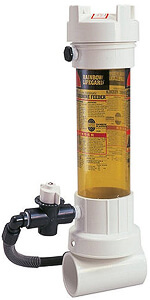FREE Standard Shipping On All Orders $100 or More!*
Automatic Pool Chlorinators: Buyer's Guide
Chlorine Tablets are the easiest and safest way to get chlorine into your pool.
Automatic Chlorinators are the perfect partner, allowing a way to provide a constant and consistent chlorine level.
Using tablets in the skimmer? That's a No-No, and can cause big problems over time.
Chlorine Floaters? Well OK, better than nothing, but less effective than a real, stand-alone chlorinator, aka chlorine tablet feeder. There are several benefits to using a chlorine feeder.
LESS HANDLING OF CHEMICALS
If you own a swimming pool, then it is guaranteed that your hands at one point have smelled like chlorine. Depending on the size of your pool and the levels you set the feeder to chlorinate, you can decrease the frequency of opening that big smelly bucket, breathing and touching chlorine, because you can stock it up with a 2-3 week supply. This alone makes owning an automatic chlorinator worth it. BUT WAIT! There's more.
SAFER FOR YOUR EQUIPMENT and SURFACES
Hopefully, you are not using chlorine tablets in the skimmer basket and are aware that this can cause big problems. If your pump is off for many hours each day, tablets in a pump basket continue to dissolve and fill the skimmer with a very strong chlorine solution that can damage skimmers, pipes, filters and heaters. Some of you already know this and there are those who may say, "Why spend $100 on an automatic chemical feeder when my $20 chlorine floater does the same job?!?"

I like floaters during winter, but the problem with floaters is that they can tip over, or come to rest on a step or ladder, or drop bits of tablets to the floor which can stain the pool. Plus, they don't allow as much control of the dissolve rate, the dial control feature of automatic chlorinators are much more precise so you don't over or under chlorinate the pool. Automatic feeders will not only save money by extending the life of your equipment and pool surfaces, you save money by not wasting chlorine.
INEXPENSIVE TO BUY, INEXPENSIVE TO FIX:
Perhaps, you are saying to yourself, "Well, an automatic chlorinator is just one more piece of equipment I have to worry about. I can just buy another twenty dollar floater every few seasons." The truth is that automatic chlorinators are actually pretty simple devices that do not have any electronic or complex mechanical parts. They are very low maintenance pool products, just keep the lid o-ring lubed, and for chlorinators installed off-line, replace your hoses and fittings every 3-5 years.
Hayward Chlorinators

Hayward Automatic Chlorinators are probably the most well known and ubiquitous of chlorine feeders on the market today.
Hayward Chlorinators are available for inground and above ground pools, in both In-Line and Off-Line versions. They feature a venturi standpipe to draw-in chlorinated water, which is easily cleaned, should it ever become clogged with residue.
9 lb capacity (inground models) is larger than most residential feeders.
Pentair Chlorinators

Rainbow Life-Gard (Pentair) Automatic Chlorine Feeders are also available in a variety of sizes, to hold 5lbs of stacked tablets, up to 40lbs for the largest model HC3330.
Rainbow feeders offer a simpler lid assembly, with fewer lid o-ring problems as a likely result. Small 4inch lid is easy to open, without a special wrench.
Rainbow Off-Line hoses are noticeably heavy duty, and the base plate is thicker than other feeders, and hold up to twisting force while removing a sticky lid.
Sani-King Chlorinators

Not a new player on the scene, King Technology has been patenting chlorine feeders since the early 70's.
Sani-King Perform-Max chlorine feeders offer the patented Inline Dispersal valve, which only wets the bottom few inches of chlorine tablets, instead of flooding the entire chamber.
Frog Chlorine feeders and New Water Cyclers also use the King Control Dial Assembly, and all have the oversized dials and lids for easier removal.
In-Line or Off-Line Chlorinator?
In-Line chlorinators are plumbed in place, into the return pipe - after all other equipment, as shown in the image below-left. Plumb the chlorine feeder into a section of clear pipe, near the ground, so chlorine gas won't back up into a heater or filter valve. You'll need a hacksaw, measuring tape and PVC primer and glue.


Off-Line chlorinators, shown right, are used when there is no room to install an In-Line chlorinator, or not enough clear space on the return pipe, after all other equipment. 2 holes are drilled into the PVC pipe, one before the filter and one after the filter. Hoses are saddle clamped to the pipe to carry water in and out of the 'Off-line' or 'Off the Pipe' chlorine feeder.
In-Line is a better way to go, for a more sturdy installation and less parts to replace. Hoses tend to become brittle over time and injection fittings will gum-up after several years. If pipe space is tight on the return line, the Rainbow 320 In-Line model (shown here with clear chamber), requires only 4" of pipe to install.
If you do install an Off-Line feeder, be sure to install the base into the concrete or into a heavy block of wood, to keep it steady while opening the lid.